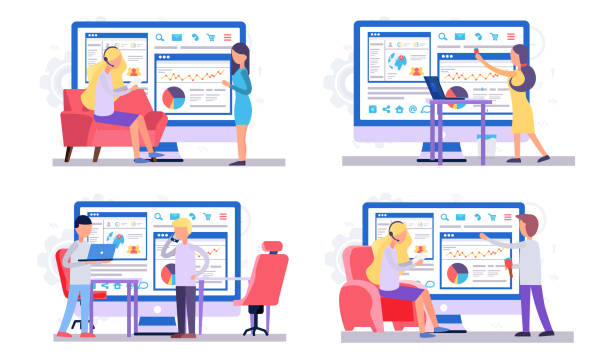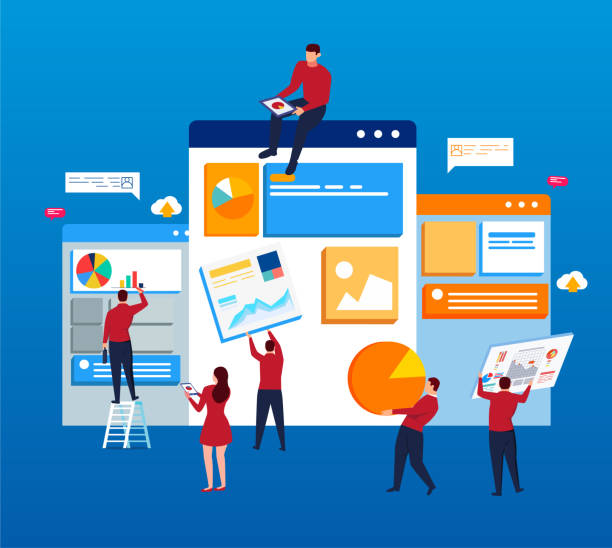Why is #Fast_Website_Design a Necessity?

In today’s digital world where speed is paramount, #fast_website_design is no longer a competitive advantage, but an undeniable necessity.
Imagine a user looking for specific information or a product, and after clicking on your link, having to wait for the page to load.
Poor User Experience (UX) resulting from low speed not only leads to an increase in Bounce Rate, but also directly negatively impacts your website’s SEO and ranking in search engines.
Search engines like Google have explicitly stated that loading speed is an important ranking factor.
A website that loads quickly not only keeps users satisfied but also allows them to easily navigate your site and achieve their goal.
This directly affects the Conversion Rate.
The faster your website, the more likely visitors are to convert into customers or perform your desired action.
The discussion of fast website design is not limited to technical issues; rather, it is a comprehensive approach to optimizing overall website performance and ensuring long-term online success.
Can we really expect success in today’s competitive landscape without focusing on speed? This is a question every business should ask itself.
Worried about losing customers because you don’t have a professional e-commerce website?
With e-commerce website design by Rasaweb, forget these worries!
✅ Significant increase in sales and conversion rate from visitor to customer
✅ Professional and user-friendly design that builds customer trust
⚡ Get free consultation from Rasaweb
Key Factors Affecting Website Loading Speed

To achieve fast website design, understanding the main factors that affect loading time is crucial.
These factors vary from technical aspects to content.
One of the most important is the quality of your hosting and server.
A slow or unsuitable server can render all your optimization efforts ineffective.
The second factor is content size and optimization, especially images and videos.
High-quality and large-sized images can severely reduce loading speed.
Image optimization (compression without loss of quality) and using appropriate formats (like WebP) are of high importance.
Website coding also plays a key role; disorganized, heavy, or redundant CSS and JavaScript codes can cause delays in page rendering.
Using optimized and modern JavaScript frameworks and libraries, instead of old and bulky versions, is recommended.
Also, the number of HTTP requests that the browser needs to fully load a page affects speed.
The fewer these requests, the faster the website loads.
This includes the number of CSS, JavaScript, image, and font files.
Using Caching also significantly increases speed, as it allows the browser to store static content and not require reloading on subsequent visits.
Finally, the complexity and number of plugins or extensions, especially in Content Management Systems like WordPress, can be a deterrent to achieving a high-speed website.
Intelligent selection and optimization of these items are the first step towards achieving fast website design.
Specialized Techniques for Website Speed Optimization

To achieve a fast website design, a set of specialized techniques must be utilized.
The first step is image optimization.
Large and high-volume images are major reasons for slow loading.
Using image compression (such as WebP), Responsive Images, and Lazy Loading can have a dramatic impact.
The second important technique is caching.
By enabling server-side and client-side caching, loading time for returning visitors can be significantly reduced.
This allows the user’s browser to store static site content, eliminating the need for repeated requests to the server.
The third item is code compression (Minification).
Removing white spaces, comments, and extra characters from CSS, JavaScript, and HTML files reduces their size and improves loading speed.
Also, combining CSS and JavaScript files into a larger single file can reduce the number of HTTP requests, although this is less important in HTTP/2.
The fourth technique is database optimization, especially for content management system-based websites.
Regular table cleanup, query optimization, and proper indexing can improve server performance.
The fifth item is using a CDN (Content Delivery Network).
A CDN stores your website’s static content on various servers in geographical locations close to your users, ensuring content is delivered from the closest server to the user, which significantly reduces response time.
All these techniques combined lead to fast website design and a high-speed website.
In the table below, you can see some technical optimization solutions:
| Factor | Description | Impact on Speed |
|---|---|---|
| Image Optimization | Compression, resizing, Lazy Load, WebP format | Significant reduction in loading time |
| Caching | Temporary data storage in user’s browser or server | Increased speed for returning visitors |
| Minification | Removing extra characters from HTML, CSS, JS code | Reduced file size, faster loading |
| CDN | Content distribution from the closest server to the user | Reduced Latency and increased global speed |
| Database Optimization | Cleaning and optimizing tables and queries | Reduced server response time |
Guide to Choosing Suitable Hosting for Speed

Choosing a powerful and optimized hosting is one of the most important decisions on the path to fast website design.
Even the best coding and client-side optimizations cannot compensate for a slow and unsuitable server.
When choosing hosting, pay attention to several key factors.
The first is the type of hosting.
Shared hosting is the cheapest option, but its resources are divided among many websites, which can severely reduce speed.
For more serious websites, consider options like VPS (Virtual Private Server), dedicated server, or cloud hosting, which offer more dedicated resources and greater flexibility.
The second factor is the server’s geographical location.
The closer the server is to your target audience, the lower the response time (Latency) and the faster the loading speed will be.
If your audience is primarily in Iran, choosing domestic hosting with powerful servers in Iran is a priority.
The third item is support for new technologies.
Ensure your hosting supports new PHP versions, HTTP/2, SSD Storage (instead of HDD), and Brotli Compression.
These technologies directly impact speed.
The fourth factor is the amount of dedicated resources.
Sufficient RAM, CPU, and disk space are essential for managing traffic and processing requests.
Checking other users’ reviews and the service provider’s high uptime is also of great importance.
Choosing a reputable hosting that is appropriate for your website’s needs is the foundation of a high-speed and successful website, and plays a significant role in website speed optimization.
This decision alone can be the differentiating factor between a slow website and a super-fast website.
Tired of losing business opportunities due to not having a professional corporate website? Don’t worry anymore! With Rasaweb’s corporate website design services:
✅ Your brand’s credibility and professionalism will increase.
✅ You will attract more customers and sales leads.
⚡ Get a free consultation now to get started!
The Importance of User Experience and SEO in High-Speed Websites

Website speed is not just a technical number; it is directly linked to two vital aspects of online success: User Experience (UX) and Search Engine Optimization (SEO).
A fast website design is the foundation of excellent UX.
Today’s users expect pages to load instantly; any delay, even a few seconds, can lead to frustration and site abandonment.
A high bounce rate indicates user dissatisfaction and signals to search engines that your site is not desirable for users.
In contrast, a high-speed website allows users to browse your site seamlessly and with more enjoyment, consume content, and perform desired actions.
This not only increases the conversion rate but also builds customer loyalty.
From an SEO perspective, Google and other search engines have explicitly stated that page loading speed is a ranking factor.
Slower websites appear lower in search results, even if they have high-quality content.
Additionally, speed impacts the ability of the search engine crawler to index your site.
Slower sites receive a lower crawl budget, meaning fewer of their pages are visited and indexed by search engines.
This ultimately leads to less visibility for your site in search results.
Therefore, website speed optimization is not only essential for your users but also a strategic investment to improve your ranking in search results and attract more organic traffic.
Fast website design is indeed a comprehensive strategy for sustainable online success.
The Role of Speed Test Tools in Fast Website Design

After implementing optimization techniques, continuous measurement and monitoring of website speed are of high importance.
Speed test tools provide a comprehensive and accurate view of your site’s performance and identify weaknesses so you can continuously strive for faster website design.
Some of the most widely used tools include: Google PageSpeed Insights, GTmetrix, and Pingdom Tools.
Google PageSpeed Insights provides a score for desktop and mobile performance, as well as practical recommendations for speed improvement, based on Google’s Core Web Vitals metrics.
This tool focuses heavily on actual user experience.
GTmetrix provides more comprehensive reports, including full page load time, number of HTTP requests, and detailed information about each resource being loaded.
This tool helps you identify bulky and slow files that are reducing your site’s speed.
Pingdom Tools is also a useful tool for measuring page load time from different geographical locations and provides valuable information on waterfall breakdown and overall performance.
Regular use of these tools not only helps you measure your site’s current speed but also allows for comparison and progress monitoring over time.
These tools also show you which elements of your website need more optimization, from images and fonts to JavaScript and CSS codes.
By relying on the data from these tools, you can make more informed decisions for continuous website speed improvement and always move forward on the path to a fast and successful website design.
This analytical approach ensures that your site always performs at its best and provides an optimal user experience.
Mobile Optimization and the Future of Fast Website Design

In the current era, where most users access the internet via mobile devices, optimizing website speed for mobile is a vital necessity.
Google, with its Mobile-First Indexing approach, has prioritized the mobile version of websites.
Therefore, a fast mobile website design is not only essential for user experience but also directly impacts your SEO ranking.
Speed issues on mobile are even more critical than on desktop because mobile users often rely on slower internet connections and more limited hardware.
Thus, extreme lightening and optimization for this platform are of particular importance.
Using responsive designs that automatically adapt to screen sizes is the first step.
However, this is not enough.
One must use images with optimal dimensions and quality for mobile, avoid heavy JavaScript scripts, and defer the loading of unnecessary resources.
Technologies like AMP (Accelerated Mobile Pages) and PWA (Progressive Web Apps) also play a significant role in this area.
AMP allows you to create very light and fast versions of your pages that load instantly.
PWA, by offering features such as offline storage and app-like user experience, can significantly improve mobile user speed and interaction.
The future of fast website design is closely tied to innovation in mobile optimization.
With the increasing use of mobile, businesses that can provide an exceptionally fast and responsive website for mobile will not only be more successful in attracting and retaining users but also gain a sustainable competitive advantage.
This is a crucial aspect of website speed optimization.
Monitoring and Maintenance to Preserve Site Speed

Achieving fast website design is not a one-time process, but requires continuous monitoring and maintenance.
After applying initial optimizations, it is important to regularly monitor your website’s performance and promptly address any issues that arise.
One important aspect is continuous updating of the platform, plugins, and themes used.
Outdated versions may have security vulnerabilities or be incompatible with newer PHP or database versions, all of which can lead to site slowness.
Monitoring server logs and checking for errors can also help identify hidden problems.
5xx errors (server errors) or 4xx errors (client request errors) can be indicators of issues affecting speed.
Also, monitoring traffic and server resources is very important.
A sudden increase in traffic or a DDoS attack can overload server resources and cause a severe reduction in speed.
In such cases, action should be taken quickly to increase resources or activate protective services.
Periodic speed tests using the tools mentioned earlier help you track changes in performance.
If you notice a decrease in speed, you can identify and resolve the cause.
Furthermore, continuous content optimization (e.g., compressing new images or periodically cleaning the database) also helps maintain speed.
Proper maintenance and active monitoring ensure that your site always remains a high-speed website and provides an excellent user experience for visitors.
In the table below, you can see useful tools for monitoring website speed:
| Tool Name | Main Focus | Key Features |
|---|---|---|
| Google PageSpeed Insights | Core Web Vitals and UX | Scoring, optimization suggestions, real user data |
| GTmetrix | Overall performance and resource breakdown | Waterfall Chart, comprehensive reports, performance history |
| Pingdom Tools | Load time and geographical location | Test from different global locations, page size, number of requests |
| WebPageTest | Advanced testing and complex scenarios | Test from different browsers and geographical locations, page load video |
Does your current corporate website present a worthy image of your brand and attract new customers?
If not, transform this challenge into an opportunity with Rasaweb’s professional corporate website design services.
✅ Significantly improves your brand’s credibility and image.
✅ Paves the way for attracting new leads and customers.
⚡ For free and specialized consultation, contact Rasaweb now!
Plugins and Helper Tools in Fast Website Design

In the world of Content Management Systems, especially WordPress, which constitutes a large part of the web, the correct use of plugins and helper tools can play a very important role in achieving fast website design.
Caching plugins like WP Super Cache, W3 Total Cache, or LiteSpeed Cache (for LiteSpeed servers) are among the most important tools.
These plugins drastically reduce server response time by creating static versions of your web pages, causing pages to be delivered faster to users.
In addition to caching, image optimization plugins like Smush or Optimole can also automatically compress and optimize your images, which reduces the overall page size and increases loading speed.
Some of these plugins also offer Lazy Load functionality, which loads images and videos only when the user scrolls to them.
Minification and file combination plugins, such as Autoptimize, help reduce the size of CSS, JavaScript, and HTML files and decrease the number of HTTP requests.
This allows the browser to process content faster.
Also, if you use a CDN, many of these plugins provide easy integration with CDN services.
The correct selection and smart combination of these plugins can help you launch a high-speed website without needing deep coding knowledge.
Of course, excessive use of plugins can also cause site slowness itself, so choosing lightweight, efficient, and essential plugins is an important principle in website speed optimization.
Always obtain plugins from reliable sources and check user reviews and their compatibility.
The Impact of Core Web Vitals on Website Speed and Ranking

The concept of Core Web Vitals, introduced by Google, provides specific metrics for measuring user experience and ultimately site speed, which directly impacts SEO ranking.
These metrics include three main factors: LCP (Largest Contentful Paint), FID (First Input Delay), and CLS (Cumulative Layout Shift).
LCP refers to the loading speed of the largest content element on the page (e.g., a large image or main text block).
The goal is for LCP to be under 2.5 seconds, so the user feels the page loaded quickly.
Improving LCP requires image optimization, caching, and ensuring fast server response.
FID measures the page’s ability to respond to the user’s first interaction (such as clicking a button or link).
If a lot of JavaScript is running and the browser is busy, FID will increase.
The goal is for FID to be under 100 milliseconds.
Optimizing JavaScript and deferring the execution of non-essential scripts can improve FID.
CLS evaluates the visual stability of the page, i.e., the amount of unexpected layout shifts of page elements after loading.
For example, if a button suddenly shifts due to an ad loading, and the user accidentally clicks on something else, CLS will be high.
The goal for CLS is under 0.1.
To improve CLS, ensure that images and advertisements have specific dimensions and that content does not suddenly shift.
Fast website design, considering these metrics, helps you not only significantly improve user experience but also achieve a better ranking in Google search results.
Adhering to Core Web Vitals means having a high-speed site that is optimized for users, and consequently, Google rewards it.
This is an important and analytical aspect of website speed optimization now and in the future.
Frequently Asked Questions
| Row | Question | Answer |
|---|---|---|
| 1 | What is fast website design? | Fast website design refers to the process of launching a functional and optimized website in the shortest possible time, without sacrificing its quality or efficiency. |
| 2 | What factors are effective in website design speed? | Using ready-made Content Management Systems (CMS) like WordPress, optimized ready-made templates, visual design tools, designer’s experience, and effective communication with the client. |
| 3 | Does fast website design always mean reduced quality? | No, with proper planning, use of optimized tools, and standard techniques, a high-quality website can be designed in a short time. |
| 4 | What types of websites are most suitable for fast design? | Small corporate websites, blogs, online resumes, landing pages, and e-commerce stores with limited products. |
| 5 | What is the role of CMSs (like WordPress) in fast design? | CMSs significantly accelerate the design and development process by providing templates, plugins, and an easy-to-use admin panel. |
| 6 | Does fast website design cost less? | Usually yes. Due to reduced designer working time and the use of ready-made resources, costs can be significantly reduced. |
| 7 | What client information is needed for fast design? | Contact information, logo, textual content, images, website goals, and any specific customization needs. |
| 8 | Do fast-designed websites have future scalability? | Yes, especially if built with popular CMSs like WordPress, new features can easily be added to them in the future. |
| 9 | What benefits does fast website design have for businesses? | Faster market entry, testing new ideas with minimal risk, reduced costs, and the ability to launch immediate marketing campaigns. |
| 10 | What is the difference between fast website design and “ready-made website”? | Fast design involves the process of designing and implementing based on client needs, even if it uses ready-made tools. However, a “ready-made website” usually refers to platforms where you simply enter your information and receive a pre-defined site. |
And other services of Rasaweb Advertising Agency in the field of advertising
Smart Content Strategy: A combination of creativity and technology to increase website traffic through Google Ads management.
Smart Direct Marketing: An effective tool for campaign management with the help of attractive UI design.
Smart Marketing Automation: A fast and efficient solution for analyzing customer behavior, focusing on Google Ads management.
Smart Conversion Rate Optimization: A fast and efficient solution for digital branding, focusing on attractive UI design.
Smart Sales Automation: Transform SEO ranking improvement with the help of attractive UI design.
And over hundreds of other services in the field of internet advertising, advertising consulting, and organizational solutions
Internet Advertising | Advertising Strategy | Advertorials
Sources
Secrets of Fast Website Design
Increase Website Speed for Online Success
Website Speed Optimization in SEO
Key Tips for Agile Website Performance
? With Rasaweb Afarin, revolutionize your business in the digital world. From secure and professional website design to SEO and targeted content marketing, we offer comprehensive solutions for your success.
📍 Tehran, Mirdamad Street, next to Central Bank, Southern Kazeroun Alley, Ramin Alley, No. 6

